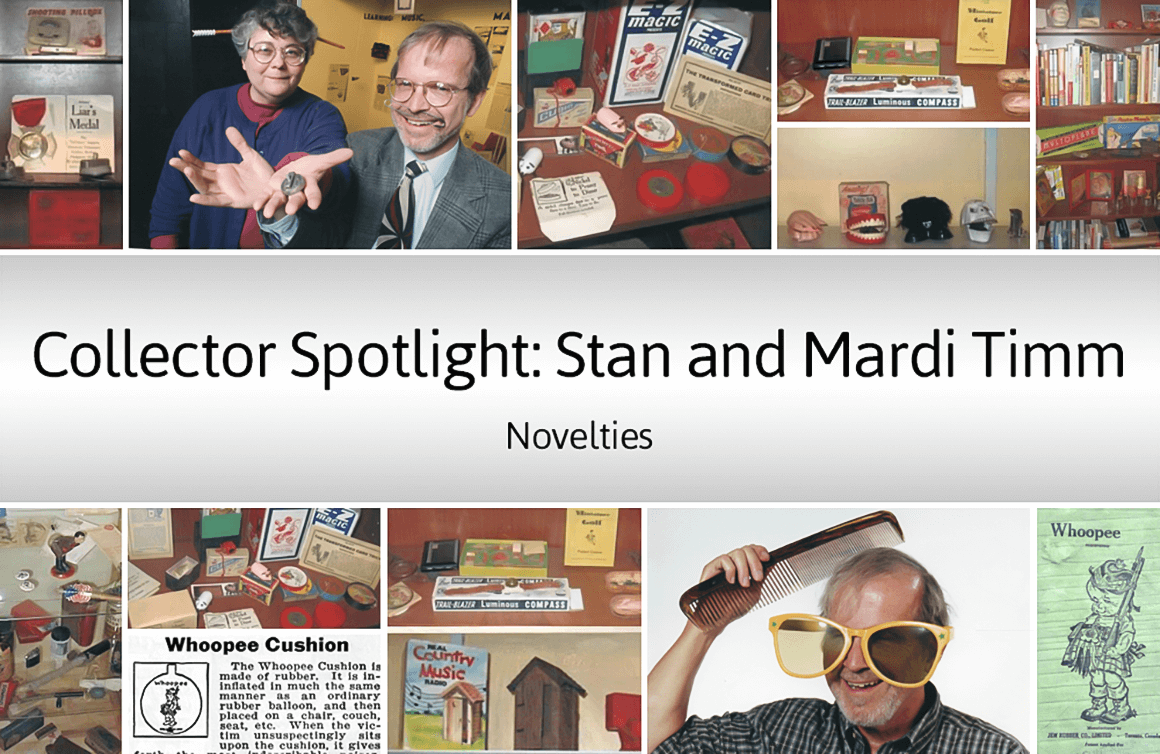Describe your collection.
Stan and I collect novelties but not everyone knows what that means. It’s almost impossible to describe because novelties are anything that was new at the time of its release. Once the fondness for a novelty dies down, something new takes its place. Novelties can include health, household, and self-improvement items. The list goes on. The items in our collection are novel, yes, but it’s not restricted to gags.
We have just under 1,800 objects catalogued. I’m always finding things around the house that haven’t been catalogued and Stan keeps buying things even though our collection is for sale. We started by collecting Johnson Smith & Company objects. Some people will know about Johnson Smith & Company, the mail-order catalogue that was often advertised in vintage magazines and comic books. Then we discovered H. Fishlove & Co. and S.S. Adams Co. Both Fishlove and Adams created and produced novelty items sold in Johnson Smith & Company catalogues. Fishlove also had an agreement with Disney to sell items at their parks. Walt Disney had seen Fishlove merchandise at roadside stores. When Disneyland was being developed, an agreement was already in place between the two men. Some of those objects can still be found at Disney parks because Fun Inc. currently owns the license to produce some early Fishlove products.
One of the oldest objects in our collection is the “Little Gem” Lung Tester and Developer, first introduced in the late 1800s. People could test their lung strength by blowing into a tube attached to a flywheel that would move to indicate lung power. The idea was that men could show their lung power and women could increase their breast size using the gadget. Some of our newer pieces are from the 1960s. We have girly glasses and a comb that puts dandruff into a person’s hair. It’s called the Dander Up Comb. We also have a kaleidoscope that leaves a black ring around the eye of the person using it. It’s been my favourite prank since I was a kid.
When and why did you start collecting novelties?
We started in the late 1980s. Stan has been a magician since he was eight. In his teens, he would get Johnson Smith & Company catalogues in the mail and would use the money he earned on his paper route to buy things from the catalogue. He lived in Beloit, Wisconsin and ordered from Johnson Smith & Company, located at the time in Detroit. One day in the late 1980s, Stan was in a bookstore and came across a 1979 reprint of a book called The Whole Fun Catalogue of 1929. He noticed a reference to Johnson Smith & Company being located in Racine, Wisconsin, where we live. We both love history so he brought the book home to show me. We wanted to know more about where the company had been located and for how long. Our interest built from that point. That was the beginning of our collection.
How do you display and store your collection?
I use Sortly to keep track of our inventory. It’s a godsend for cataloguing anything and is very affordable.
At one time we set up an appointment-only museum in our house. We created an interactive wall of gag boxes so people could actually touch the objects to see how they work. We wanted people to be able to touch the items because that’s the fun of it. What’s the point of keeping gag boxes in a cabinet? There were occasional mishaps but I’ve broken things, too. Even if an object is fragile, I’ve tried it.
We never store things in paper boxes because temperature and humidity is always a concern. We use plastic boxes on rolling carts and sets of drawers so we can easily find things. Most items are very small so storage doesn’t take up much space. I think we have about 30 2’x4’x10″ boxes in total. Our collection is for sale right now so most of it is put away. We’d like to sell it as a complete collection to keep the history intact.
What do you consider to be the Holy Grail of novelties?
One object that I would love to have is the question-mark stanhope from the 1920s or 1930s. It’s a scarf pin made of rhinestones in the shape of a question mark. One of those rhinestones is a stanhope — a piece that allows you to peer through it to see a tiny photograph or written words. It cost about 25 cents at the time it was first produced. I have looked for years for that pin but never found one.
The other object I would like to have is also a pin, this time from the Safety First movement of the 1900s. It’s an actual safety pin with a tiny numeral one with “S” and “T” charms hanging from it.
The Holy Grail of our collection would have to be an original whoopee cushion from Toronto, Canada manufacturer JEM Rubber Company.
What advice would you give to someone interested in starting a novelty collection?
Just go with what you love, find funny, or is of interest to you. There is so much history to discover in novelties. Even though an object may be considered passé now, there was a time when it was new and novel. It tells a story of the society and culture in which it was made. At one time the flashlight was a novelty; it was a brand-new thing. Everything we have at one time was a novelty. If you’re interested in the history of a particular era, novelties are a way to explore that. That’s what’s so fascinating about these artefacts.
Read more about the Timm’s collection in this article from Collectors Weekly
Drop us a line to let us know about your collection of vintage toys and/or games. We just may feature your collection!


